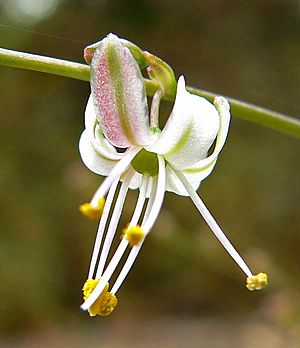Chlorogalum purpureum facts for kids
Quick facts for kids Chlorogalum purpureum |
|
|---|---|
 |
|
| var. purpureum | |
| Conservation status | |
| Scientific classification |
Chlorogalum purpureum is a special flowering plant often called the purple amole. It's a type of soap plant and is related to the agave family. This plant is found only in California, especially in the Santa Lucia Range along the Central Coast. It's quite rare and is listed as a federally threatened species, meaning it needs protection to survive.
There are two main types, or varieties, of this plant. Both are considered very rare and important to protect.
Contents
What is the Purple Amole Plant Like?
The purple amole (Chlorogalum purpureum) is a plant that lives for many years. It grows from a round underground part called a bulb, which is usually about 3 centimeters wide. The plant has long, thin leaves that are a bright green color and have a thick line down the middle. These leaves grow from the base of the plant, usually one to eight of them, but sometimes up to fourteen!
The stem of the plant has flowers that are spaced out. Each flower has small, curled petals, called tepals, that are less than a centimeter long. Unlike other soap plants that have white or pink flowers, the purple amole's flowers are shades of blue or purple. The flowers also have long parts called stamens with yellow tips, which are called anthers. These surround a central part called a style.
Two Types of Purple Amole
The two varieties of this plant can be told apart by their size:
- Purple amole (var. purpureum) can grow up to 40 centimeters (about 16 inches) tall. About 90% of all purple amole plants are of this type.
- Camatta Canyon amole (var. reductum) is smaller, reaching only about 20 centimeters (about 8 inches) tall.
Where Does the Purple Amole Live?
This plant grows in a Mediterranean climate, which means it has hot, dry summers and wet winters.
Purple Amole's Home
The purple amole (var. purpureum) is found only in the Santa Lucia Range. This area is located in Monterey and San Luis Obispo Counties in California. It's known from only two places:
- Fort Hunter Liggett, a U.S. Army base.
- Camp Roberts, a National Guard post.
There are only four groups of these plants in total, with probably fewer than 10,000 individual plants. They live in grasslands that have patches of oak trees.
Camatta Canyon Amole's Home
The Camatta Canyon amole (var. reductum) is found only in the La Panza Range in the middle of San Luis Obispo County. This is about 61 kilometers (38 miles) away from where the purple amole grows. There's only one group of these plants, and it's hard to count them because they don't bloom every year. They can even stay dormant (like sleeping) for several seasons!
Both types of purple amole grow in soil that has a special living layer on top called a cryptogamic crust. This crust is made of tiny living things like cyanobacteria. The soil underneath is usually clay with a layer of loam and some gravel on top.
Many areas where these plants grow have been broken up by past farming. Other plants that often grow near the purple amole include:
- Rusty popcornflower (Plagiobothrys nothofulvus)
- Miniature lupine (Lupinus bicolor)
- California goldfields (Lasthenia californica)
- Yellowflower tarweed (Holocarpha virgata)
- Wavyleaf soap plant (Chlorogalum pomeridianum)
The Camatta Canyon amole prefers dry, rocky, red clay soils. It's often found in a unique type of soil called laterite, not in serpentine soils as some might think. Other plants found near it include:
- Crown brodiaea (Brodiaea coronaria)
- Bluedicks (Dichelostemma capitatum)
- Winecup clarkia (Clarkia purpurea)
- Sometimes chamise (Adenostoma fasciculatum)
Scientists have noticed that if there's a lot of rain in the winter, more purple amole plants will bloom the following spring!
Why is the Purple Amole Protected?
This plant only grows in a few specific places, making it very special and needing protection.
Threats to the Purple Amole
Even though the main areas where purple amole grows are safe from building projects, there are still dangers:
- Animals: Gophers sometimes eat the plants, and feral pigs (wild pigs) can eat the bulbs and damage the ground by trampling it.
- Off-road vehicles: Areas where Camatta Canyon amole grows are sometimes used by people riding off-road vehicles. This can damage the delicate cryptogamic soil crusts.
- Cattle grazing: Herds of grazing cattle can also damage the soil crusts.
- Invasive plants: Plants that are not native to the area can move in. These non-native plants are a big threat because they can outcompete (grow better than) the purple amole. They can also change how often wildfires happen in the area.
- Wildfires: The Camatta Canyon amole grows in one small, clustered group. A single large wildfire could greatly reduce its numbers.
- Other activities: Military activities and road maintenance can also pose a risk to the plant's habitat.
Protecting the purple amole means protecting its special habitat and making sure these threats don't cause it to disappear.
Images for kids



